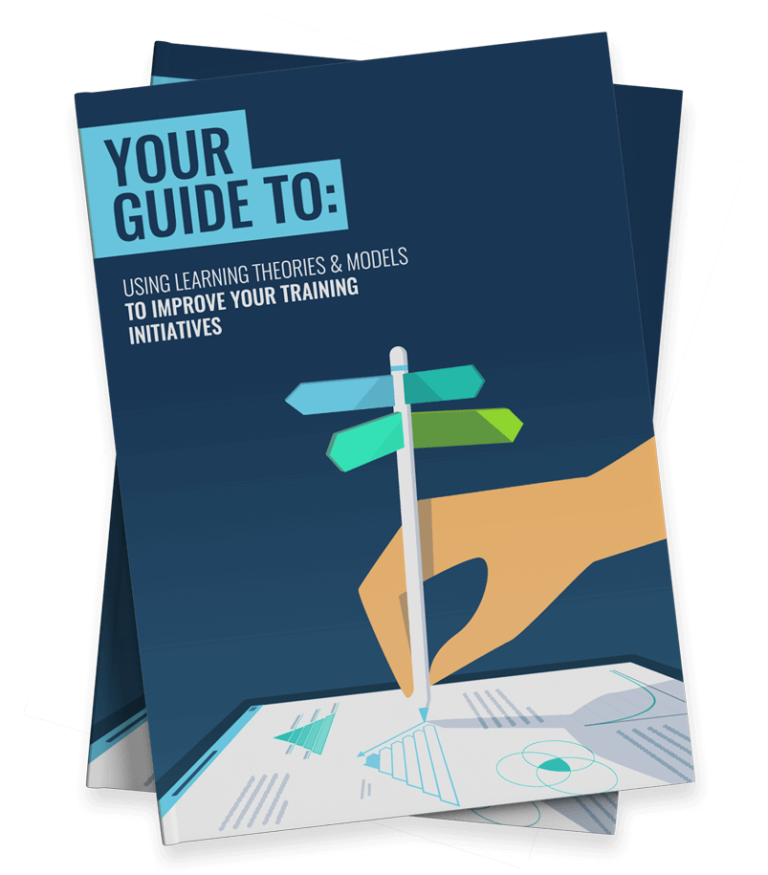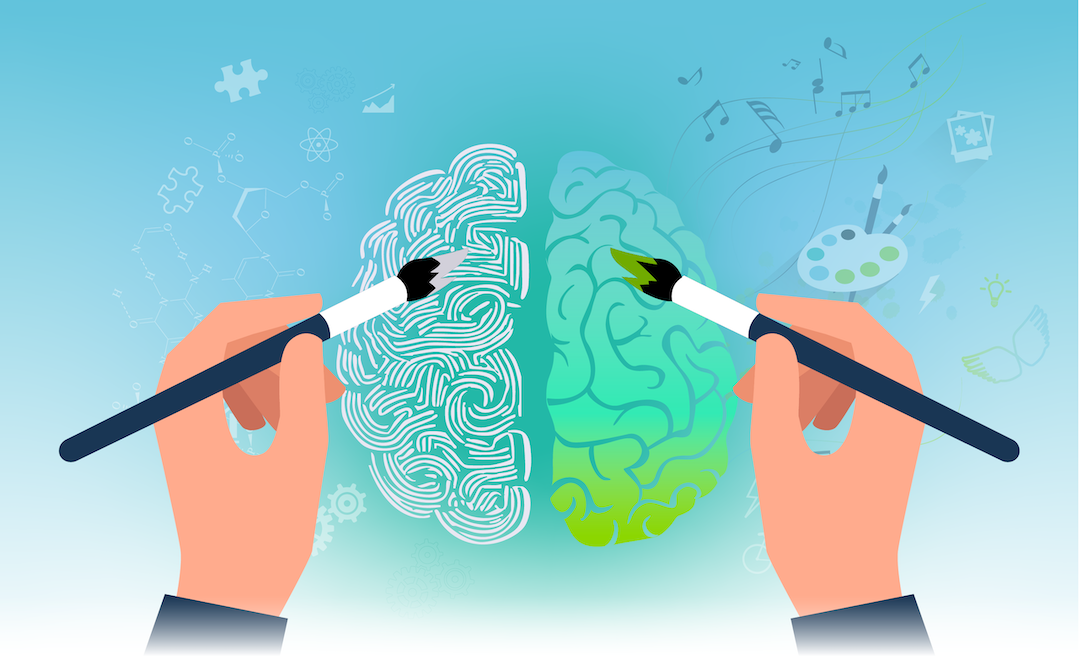Like with fingerprints, our brains are all unique. As a result, no two learners are alike. This is why there are a number of different ways we learn and a variety of different learning theories.
Psychologists and researchers have spent countless years hypothesising, researching and experimenting to better understand how we learn. In this article, we’ll explore 12 of their most popular and influential theories.
In doing so, we’ll see how our understanding of learning has changed over time, moving from simplistic behavioural theories to theories that foreground experience, reflection and engagement.
If you’d like to learn more about the key models and taxonomies that affect learning and development programmes, then please check out this article. In the meantime, let’s get started with a definition.
What is a Learning Theory?
Learning theories are conceptual frameworks that explain how we best acquire, retain, recall and apply new knowledge and skills. They consist of premises and conclusions and are sometimes based on models or taxonomies.
Put another way, learning theories explain the processes that take place during learning and provide insights into the factors that influence us during this experience. As a result, they’re remarkably useful tools for educators, instructors and trainers.
The choice of a learning theory often depends on the context, the nature of the subject matter and the preferences of your learners. As such, it’s good to have widespread knowledge of the options available to you.
With this in mind, let’s dig into the theories themselves.
12 Learning Theories You Have to Know!
1. Behaviorism Learning Theory
Major Proponent: B.F Skinner
Behaviorism is a theory that focuses on observable behaviours and external stimuli, without considering internal mental processes. It emerged as a dominant force in psychology in the early 20th century.
To put it simply, our behaviour is shaped by our environment. As a result, you can teach new behaviours by conditioning your learners’ response to stimuli. In the context of a learning programme, this means introducing positive and negative reinforcement.

Behaviorism was founded by the American psychologist John B. Watson. However, it was the research conducted by Ivan Pavlov, Edward Thorndike and B.F. Skinner that led to the formulation of operant conditioning. This is typified by Pavlov’s dog experiments.
- An unconditioned stimulus (e.g. food) is introduced. This naturally produces a response (e.g. dog salivation).
- Another unconditioned stimulus (e.g. the bell) is introduced. This naturally produces no response.
- The combination of two unconditioned stimuli (e.g. bell and food) is used to programme (i.e. condition) a response (e.g. salivation).
- This results in the conditioned stimulus (e.g. the bell) eliciting the same response as the food. Hence, the dog salivates when the bell rings as the only stimulus.
This shows us that behaviours can be learned through the association of various stimuli. With that said, behaviourism does tend to oversimplify the learning process. After all, it doesn’t leave room for any cognitive factors. That brings us to our next theory!
2. Cognitivism Learning Theory
Major Proponent: Jean Piaget
Cognitivism suggests that we are more than just a product of our environment. We are active agents. Indeed, cognitive learning theory suggests that internal processes and external factors are both important elements within a learning experience.
Plato and René Descartes (famous for “Cogito, ergo sum”, i.e. I think, therefore I am) are two of the first philosophers that focused on cognition and how we think. This led to a lot more research in the area, including the work of Jean Piaget.
According to Piaget and this theory, understanding experiences is the way to learn. As learners understand how their thinking impacts their learning and behaviour, they are able to assert more control over it.
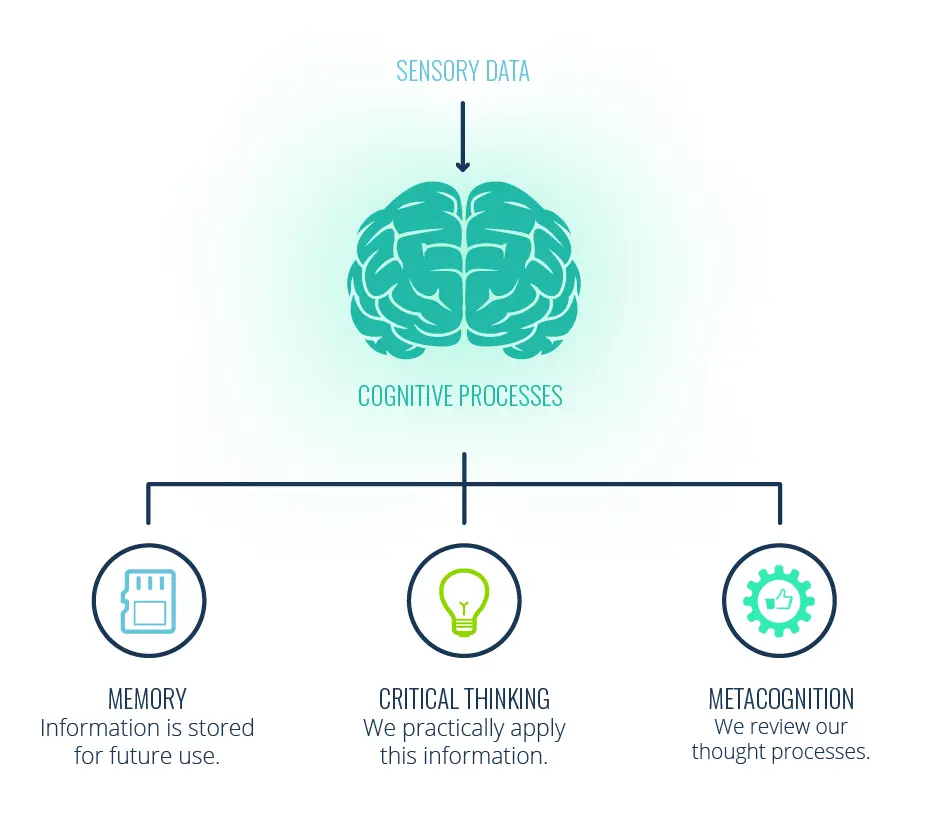
Whilst behaviourism suggests that learners have a passive conditioned role in learning, cognitivism suggests that they actually play a more active role. Let’s break down the key principles of cognitive learning theory.
- Information Processing: Cognitivism views the mind as a processor of information. It doesn’t just collect data, it organises and makes sense of it. We’ll see this view expanded on later with Information Processing Theory.
- Memory: This theory also foregrounds the role of memory (short-term and long-term) in a learning process. Without memory, cognitive functioning is simply not possible.
- Critical Thinking: With cognitivist approaches, learners aren’t passive recipients of information. They are actively engaged and use their problem-solving and critical thinking skills throughout the process.
- Metacognition: The theory also recognises that we have awareness and control over our thought processes. This means we are able to plan, monitor and evaluate our own learning progress.
3. Constructivism Learning Theory
Major Proponent: Jean Piaget
The aptly named constructivist learning theory built on behaviourism and cognitivism by placing the learner at the centre of every learning experience.
Indeed, constructivism suggests that learners actively construct their understanding of the world as a result of their experiences and interactions. This focus proved to be highly influential for the likes of John Dewey and David Kolb (more on them shortly).
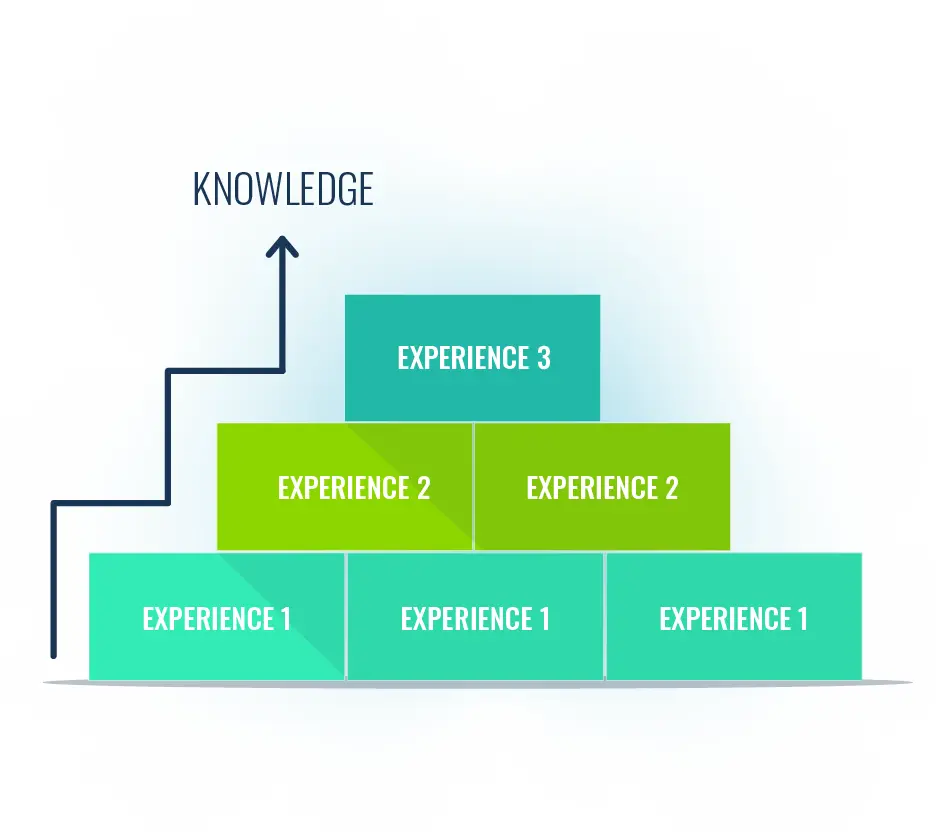
This construction process is personal and unique to each learner. As a result, the theory recognises that learning outcomes will differ based on how learners interpret their experiences. The key principles of constructivism include:
- Active Learning: Learning is not a passive process. We must be actively engaged to drive positive outcomes. As a result, we should strive to deepen our understanding by exploring, questioning and problem-solving.
- Prior Knowledge: Constructivism recognises that learning isn’t a one-off event. Our previous knowledge and experiences have a role to play. We use these experiences to add context to information and structure to what we learn.
- Scaffolding: As learning is a construction process, a good learning experience benefits from structure. For instance, we should break topics up into chunks and start at a beginner level before diving into more complex subject matter.
- Reflection: With a constructivist approach, learners are encouraged to think about their thinking. In other words, we reflect on our experiences to help develop a deeper understanding.
4. Humanism Learning Theory
Major Proponent: Abraham Maslow
Humanism is a philosophy that suggests we’re all seeking self-actualisation. This is the point at which all our needs are met and we feel content that we are the best possible versions of ourselves. This focus is what drives our growth.
This sense of direction, when combined with human values (such as respect and empathy) helps to fuel positive learning experiences. Indeed, humanism stands in stark contrast to behaviourism and cognitivism, as it highlights the value of our own subjective experiences.
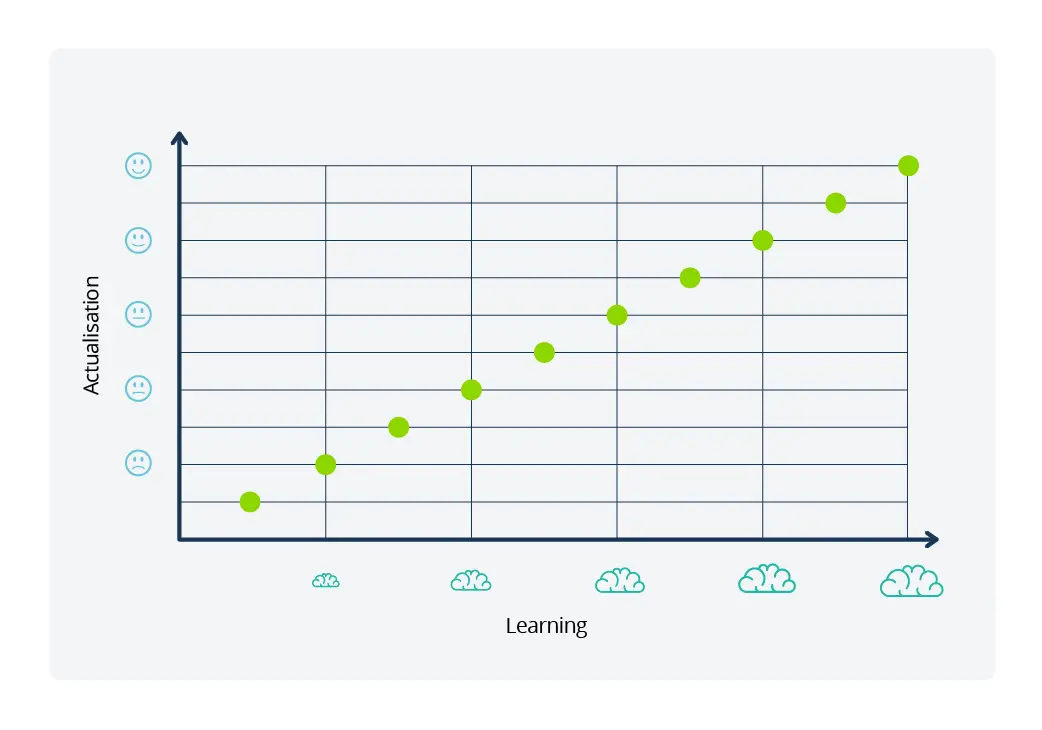
Most humanists don’t actually believe that any of us achieve self-actualisation. This is almost besides the point. It’s the pursuit that matters. As a result, these are the central tenets of humanistic learning theory:
- Learner-Focused: Humanism places the learner at the centre of every learning experience. It champions personalised learning programmes that are characterised by exploration and discovery.
- Autonomy: Similarly, learners should be free to explore and engage at their own pace. This encourages them to take responsibility and ownership over their learning experiences.
- Needs Satisfaction: The theory also recognises that we must first satisfy our basic needs before we seek to achieve more lofty goals. Self-actualisation is difficult if you don’t have a roof over your head or food on your plate.
- Holistic Development: According to humanists, we shouldn’t just focus on building our intellectual capacity. We should also seek to improve our emotional and social capabilities.
5. Connectivism Learning Theory
Major Proponent: George Siemens
Connectivism is a theoretical framework for understanding how we learn in the digital age. It explores how technology enables us to connect, engage and share information. It was first introduced in 2004, which makes it the newest theory on this list.
Stephen Downes describes connectivism as “the thesis that knowledge is distributed across a network of connections, and therefore that learning consists of the ability to construct and traverse those networks”.

This theory suggests that humans acquire and process information by forming connections. In this sense, we’re like databases. We capture more data as we interact with a variety of data sources and devices.
Learning happens when we connect information together and technology helps to facilitate these connections. This makes the connections that empower us to learn considerably more important than our existing knowledge base.
Modern organisations already use some principles of connectivism in their L&D programmes. However, to fully utilise connectivism, you’ll need to have a digital learning strategy in place enabled by a learning platform, social media, forums, videos and blogs.
6. Social Learning Theory
Major Proponent: Albert Bandura
When you break it down, social learning theory is quite simple. It suggests that learning is a cognitive process that takes place in a social context. This means that new behaviours can be acquired by observing and imitating others.
This theory arose in the 1960s as a response to the behaviourist models that were popular at the time. For Albert Bandura, learning doesn’t happen solely by interacting with our environment. It’s also a byproduct of our interactions with other individuals.
He demonstrated this with his Bobo Doll Experiment. When children observed adults displaying aggressive behaviours toward an inflatable doll, they were more likely to imitate this behaviour in turn. This shows us the impact of social modelling and reinforcement.
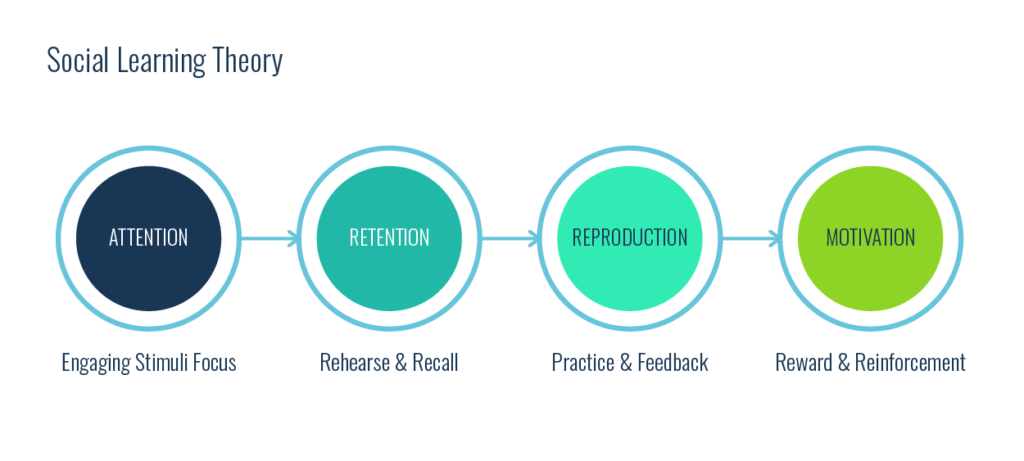
According to Bandura, imitation is driven by the following mediational processes:
- Attention: First things first, you need to grab your learners’ attention. After all, imitation can’t happen without engagement. Our conscious minds can only handle 40-50 bits of information a second, so make sure yours stands out.
- Retention: It’s not enough just to observe. You also need to process and remember what you’ve seen. It’s only then that you can use this information to drive future behaviour. After all, social learning is usually not an instantaneous process.
- Motor Reproduction: We must also be physically, mentally or emotionally capable of imitating the action in question. Merely observing Michael Jordan make a three-pointer doesn’t grant us the ability to reproduce such a skill.
- Motivation: Last but not least, motivation plays a key role in behaviour change. If we see no benefit in imitating the behaviour then we are unlikely to do so. But if we observe that it leads to positive outcomes then we’re likely to change our tune.
7. John Dewey’s Learning Theory
Major Proponent: John Dewey
John Dewey (1859-1952) was a renowned American philosopher and educational reformer. His views on education are collectively known as John Dewey theory or John Dewey’s learning theory.
This theory is linked to Dewey’s broader philosophy of pragmatism. It emphasises the role of experience, inquiry and problem-solving in the learning process. In other words, learning is an active process that goes beyond rote memorisation.
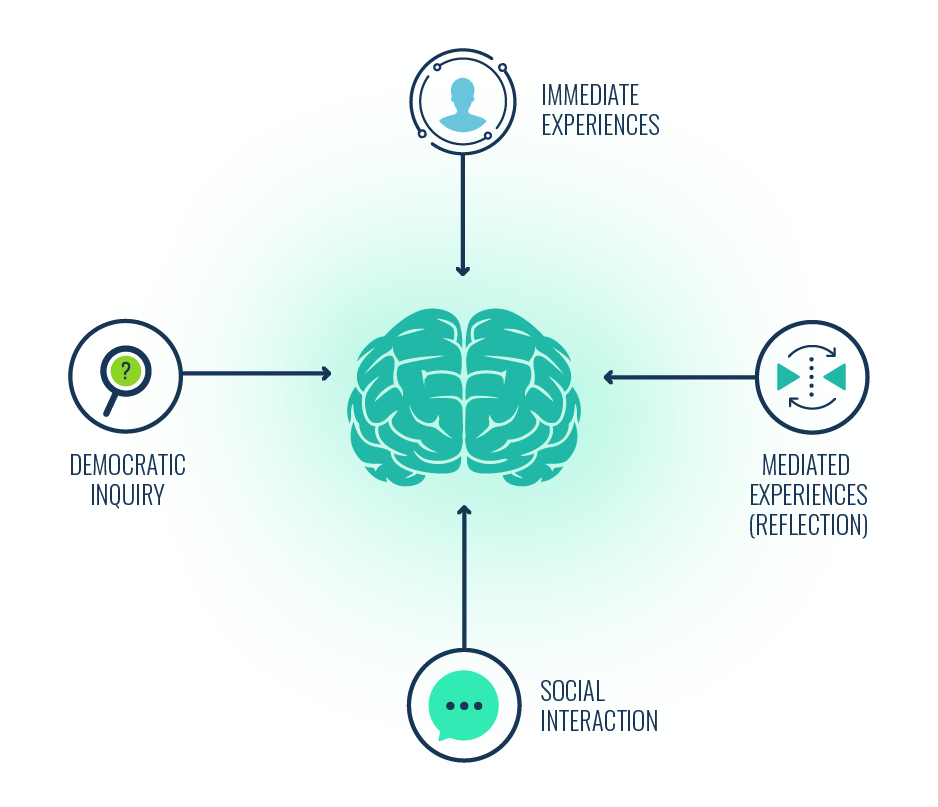
As Dewey notes, “there is an intimate and necessary relation between the process of actual experience and education”. Moreover, learning experiences become even more meaningful when we are given opportunities to engage, question and critique.
Unfortunately, Dewey’s theory lacks formal structure. With that said, here are its central tenets as we see them:
- Learning happens through experience, or by getting ‘hands-on’.
- Learning is not a passive process. It requires active engagement.
- Learning takes place within a social context.
- Learning should be a democratic process.
- Reflecting on our experiences produces more meaningful learning outcomes.
8. Experiential Learning Theory
Major Proponent: David Kolb
According to American educational theorist David Kolb, learning is the process of transforming experience into knowledge. In other words, we learn by doing. He first formulated this theory in a popular 1984 paper.
Let’s hear from the man himself. According to Kolb, learning is “the process whereby knowledge is created through the transformation of experience. Knowledge results from the combinations of grasping and transforming the experience.”
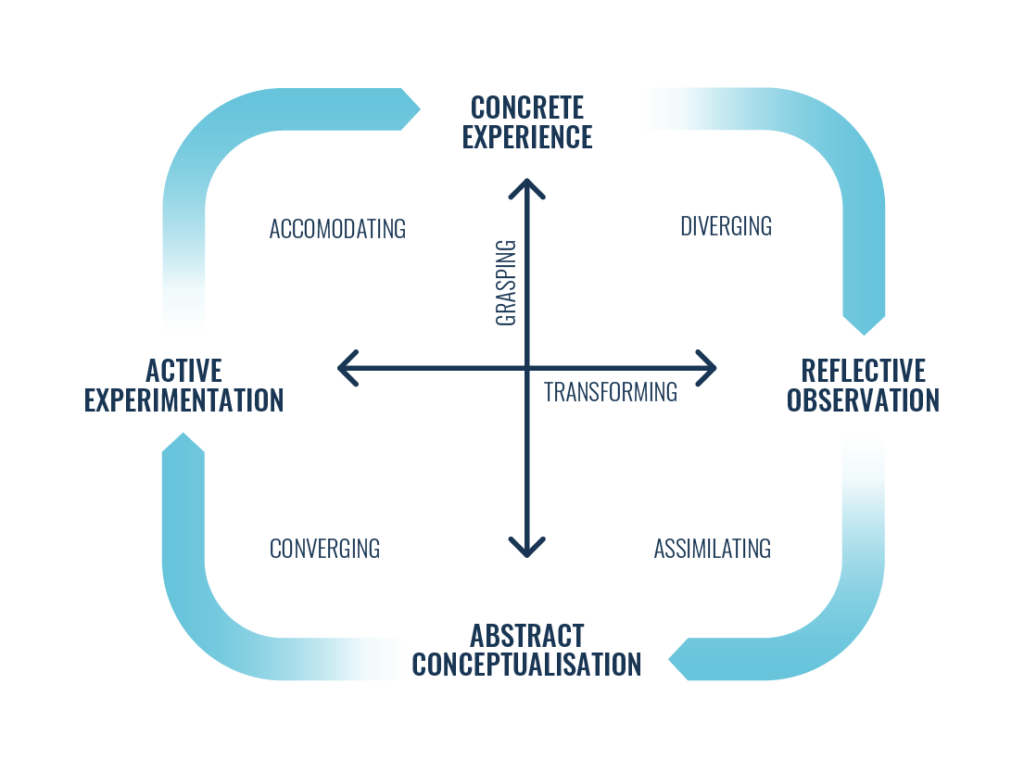
As you may be able to tell, Kolb was heavily influenced by John Dewey (as well as the likes of Kurt Lewin and Jean Piaget). However, he took things a step further by outlining the experiential learning cycle. This cycle has four different stages.
- Concrete Experience: Learning begins with a direct experience or a specific event. At this stage we get hands-on and engage in a particular activity.
- Reflective Observation: Once the experience is over, we then reflect on what happened. Typically we’ll consider how it made us feel and what we learnt.
- Abstract Conceptualisation: Following this, we’ll then analyse our reflections and draw conclusions. This can lead to us forming new ideas and hypotheses to test.
- Active Experimentation: Armed with these insights, we’ll then test out what we’ve learned in different contexts. This experimentation leads to the cycle starting anew.
9. Information Processing Theory
Major Proponent: George Miller
Information processing theory first emerged as a cognitivist framework in the 1950s. It focuses on what we do with information or stimuli once we come across it. Ultimately, we don’t just collect data. We use various cognitive processes to catalogue, store and apply it.
The theory draws an analogy between the human mind and the functioning of a computer. After all, a computer doesn’t just receive data. It codes information, stores it and uses it to produce an output. We do the same thing when we receive information.
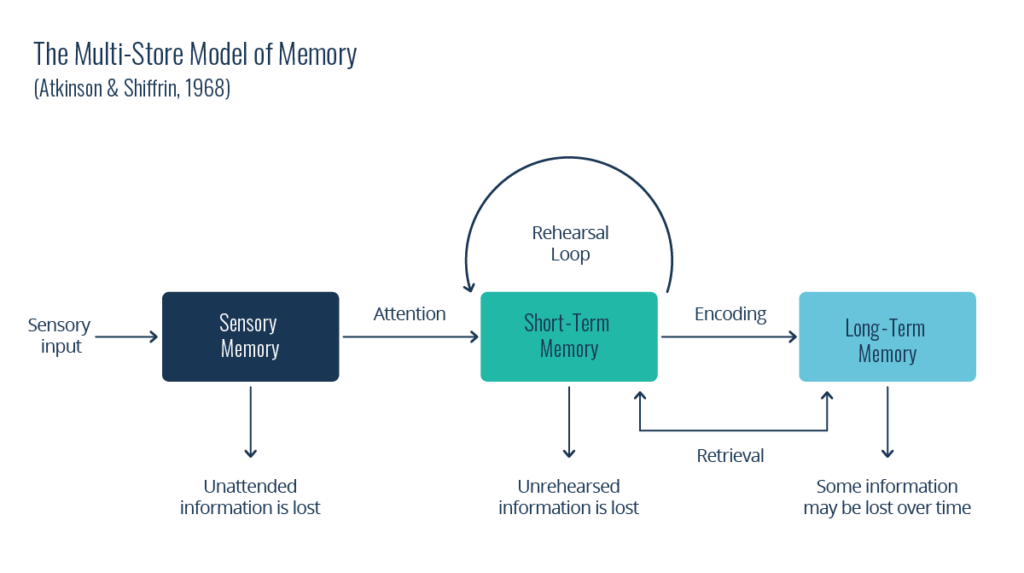
This analogy also led to George Miller discovering the capacity of our working memory. It’s generally agreed that we can hold up to seven items in mind at any given moment (plus or minus two items).
The key components of information processing theory include:
- Input: This represents the sensory data that we receive. It’s the result of what we see, what we hear, what we touch and so on.
- Processing: We then process this sensory data using our cognitive faculties. As a result, this information is encoded, organised and stored for future use.
- Output: Processing this data creates an output or a response. This can help to guide decision-making or lead to behaviour change.
- Feedback: We receive feedback from our output in the form of new sensory data. This is fed back into the model and the process begins again.
10. Theory of Multiple Intelligences
Major Proponent: Howard Gardner
The theory of multiple intelligences was first put forward in 1983 by Howard Gardner, an American psychologist and Harvard professor. It remains popular to this day, despite lacking empirical evidence.
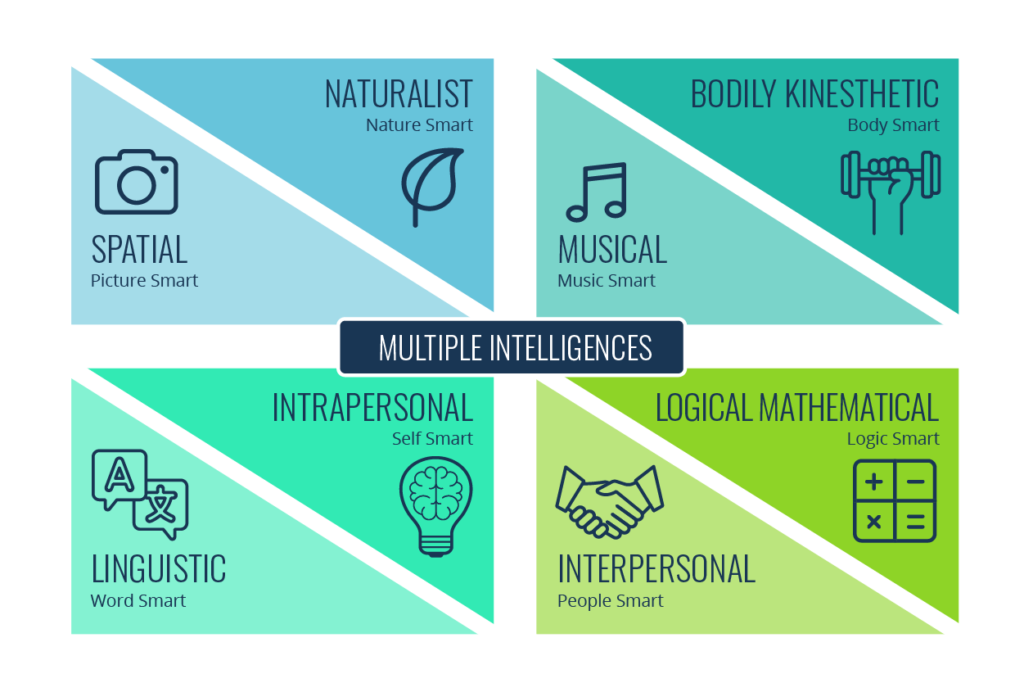
Gardner suggested that there are various distinct types of intellectual competencies. In other words, a single IQ test is inefficient. Human intelligence is more complex than this. In fact, it can be broken down into eight different categories.
- Linguistic: The ability to grasp and communicate concepts through words and symbols.
- Logical / Mathematical: The ability to effectively use numbers and recognise patterns.
- Spatial: The capability to process information though qualities like shape, form and size.
- Bodily-Kinesthetic: The ability to perform activities that require strength, speed, dexterity or coordination.
- Musical: The ability to perceive, interpret and express oneself through various musical forms.
- Interpersonal: The ability to understand and easily relate to others.
- Intrapersonal: The ability to understand and regulate your own emotions and behaviour.
- Naturalist: The ability to recognise and categorise the world around us.
It’s worth noting, Gardner never claimed that we as individuals are confined to a particular type of intelligence. We all possess multiple abilities to varying degrees and all types of intelligence are equally valuable.
11. Adult Learning Theory
Major Proponent: Malcolm Knowles
Malcolm Knowles was an influential educator and theorist who is often referred to as the father of andragogy — the art and science of adult learning. His groundbreaking adult learning theory was formulated in the late 1970s and early 80s.
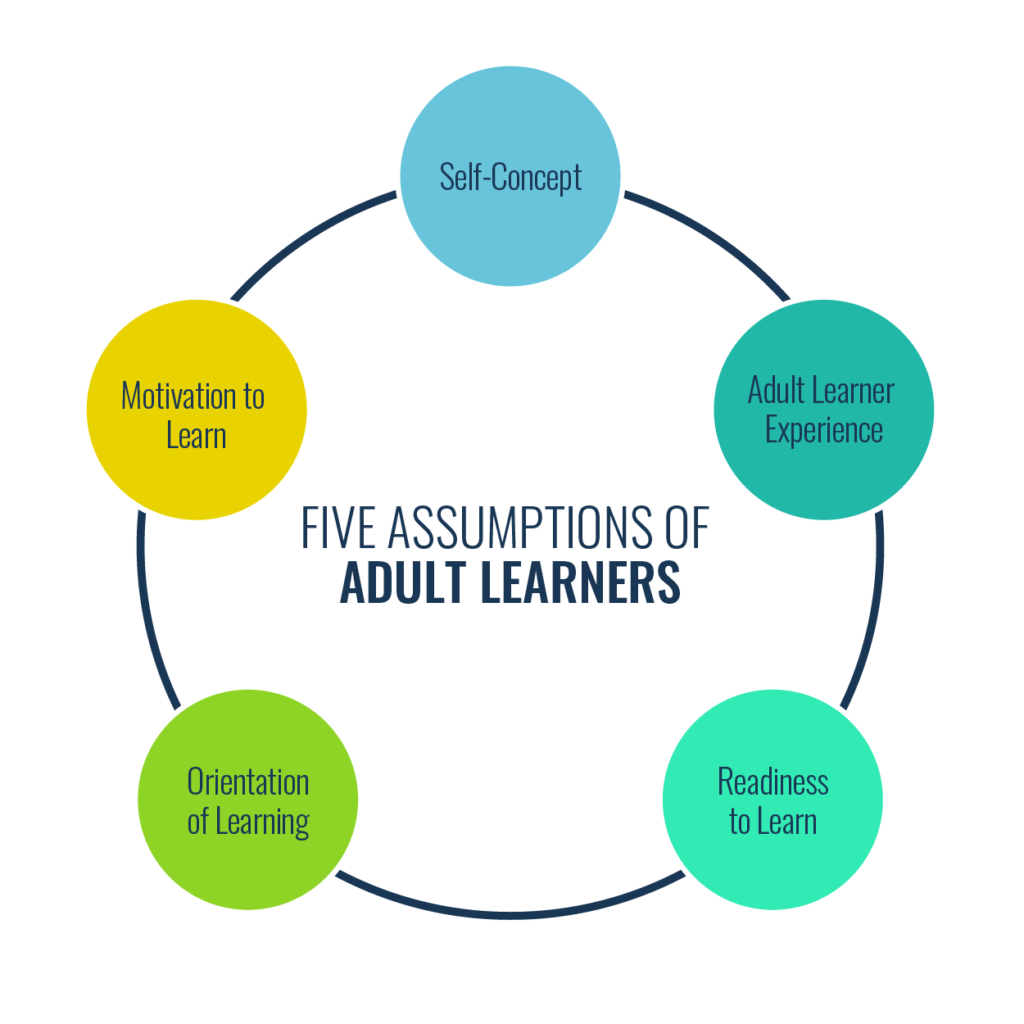
This theory was important because it highlighted the ways that adult learners differ from younger learners. After all, you’ve probably noticed that it gets harder to learn as you get older. Knowles’ theory helps us to understand why.
Adult learning theory is based on five key assumptions.
- Self-Concept: As we grow older, our understanding of our position in the world changes. Adults, unlike children, understand that they are responsible for their own wellbeing and are capable of making their own decisions.
- Experience: Adults also bring a wealth of experience to every learning opportunity. This in itself is a valuable resource. Incorporating life experiences into educational processes can enhance engagement and improve learning outcomes.
- Readiness: Adults have a variety of responsibilities to contend with. As such, they are drawn to learning experiences that contain relevant information and are applicable to their lives.
- Orientation: Likewise, adults are interested in practical information that can help them to solve problems, make better decisions or improve their standing. Our current circumstances matter.
- Motivation: Finally, whilst children are primarily motivated by extrinsic factors, this changes as we grow older. We often come to appreciate intrinsic factors, such as the desire for personal growth or fulfilment.
12. Self-Determination Theory
Major Proponents: Richard Ryan and Edward Deci
Let’s wrap things up with a theory of motivation. After all, motivation plays a leading role in the success of any learning and development initiative. Without it, your programme is doomed to failure.
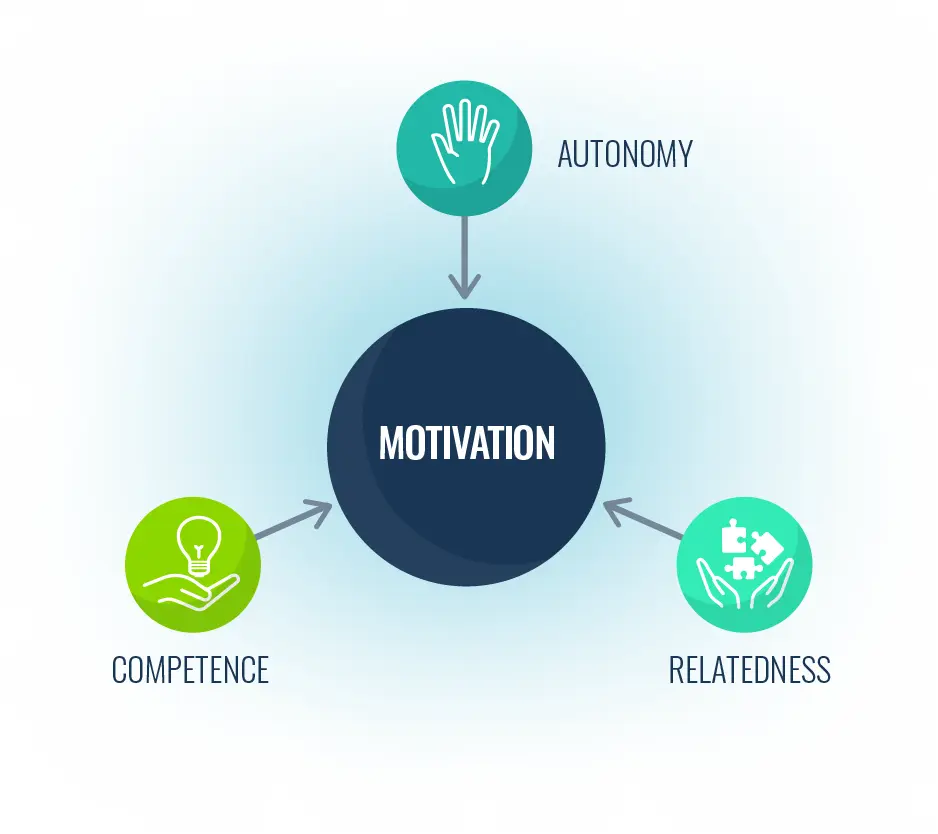
Self-Determination Theory posits that we have three basic psychological needs that contribute towards intrinsic motivation and well-being. If we can satisfy these needs, we can help to motivate our learners to take action.
- Autonomy: We need to feel like we have freedom of choice and control over our actions. This sense of self-direction is powerful. If we feel like we are being coerced or controlled, our motivation levels will plummet.
- Competence: We also need to feel effective within the environment or context in question. That sense of accomplishment is deeply satisfying. On the other hand, we tend to shy away from opportunities to showcase our own shortcomings.
- Relatedness: Finally, we also have a need to connect with others. We long to feel a sense of belonging and attachment. We are drawn to opportunities that fulfil this need and are less interested in existing in a social vacuum.
If these three psychological elements are in place, then we achieve self-determination. And if you’ve cultivated an audience of self-determined learners then you won’t need to rely on external rewards to change their behaviour.
Final Words
There you have it, a full breakdown of 12 of the most influential learning theories. As we’ve seen, these different theories offer a rich tapestry of perspectives on how individuals acquire knowledge and skills.
Whilst a behaviourist focuses on observable behaviours and external stimuli, cognitivists direct their attention to mental processes. These theories have evolved over time, with learners starting to take a more central role.
Indeed, Albert Bandura emphasised the significance of social interaction and David Kolb placed experience at the forefront of the learning process.
No single theory provides a comprehensive explanation of the complexities involved in a learning process. Instead, you should seek to synthesise these theories to craft versatile learning programmes that empower your learners.
These learning theories provide you with a toolbox of strategies. Now it’s time to get to work.
Thanks for reading. Still hungry for more influential learning theories and models? Download our white paper, ‘Using Learning Theories and Models to Improve Your Training Strategy’ now!

